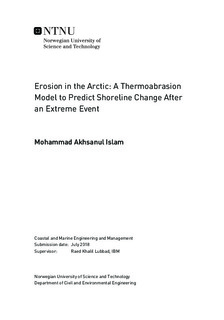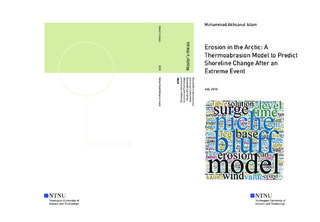| dc.description.abstract | Erosion process in the Arctic is broadly classified into two categories: thermoabrasion and thermodenundation. The study completed under this MS framework is focused on thermoabrasion process. A numerical model is developed to predict the shoreline erosion during an extreme event like a storm.
A conceptual model identified the thermoabrasion erosion as a combination of three separate physical processes (1) storm surge flooding, (2) wave cut niche growth and (3) bluff collapse. For each physical process, a separate numerical module was developed. The numerical modules dynamically interact with each other and estimate erosion rate. The model developed under the study is 1D and uses a probabilistic approach by considering distribution patterns of the input parameters. The results were found to be in good agreement with field measurements of Baydara Bay, Russia.
A sensitivity analysis was performed to demonstrate the relative impact of the input parameters on the model. Thermoabrasion erosion rate was found to be greatly dependent on sustained wind speed during the storm, inundation depth at the base of the bluff from storm surge and ice wedge polygon size. In conclusion, the limitations of the model and the scope of future research are outlined. | |

